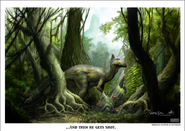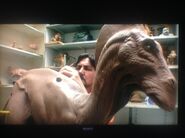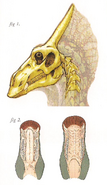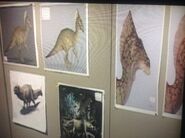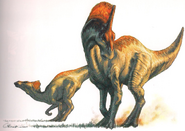|
Ligocristus
| |
|
Name:
|
Ligocristus innocens
|
|
Abilities and Weapons:
|
Strength, Keen Senses, Speed, Powerful Swimmer, Herding Behavior
|
|
Occupation:
|
Grazing primary consumer
|
|
Home:
|
Skull Island, now on Monster Isle
|
|
First Appearance:
|
"King Kong" (from 2005)
|
|
Diet:
|
Herbivore
|
|
size
|
Length: 7.9-10.3 meters
Height: 4.8 meters Weight: 3-4 tons |
|
Status:
|
Rescued from extinction during the 1938 fall exploration of Skull Island.
|
Ligocristus innocens ("harmless hoe-crest") is a 26-34 feet long (7.9-10.3 meters) and 16 feet tall (4.8 meters) species of hadrosaurid ornithopod dinosaur that is found on Skull Island. The animal is described in the book "The World of Kong: A Natural History of Skull Island" (from 2005).
Facts[]
The Ligocristus is a common, gregarious Saurolophus-like lambeosaurine hadrosaur from the lowlands of Skull Island. The most numerous large herbivores on Skull Island, Ligocristus congregates in herds numbering several dozen individuals. Ligocristus are hadrosaur ornithischians, with broad, three-toed feet and distinctive wide, duck-like snouts. With no other defenses, safety is found in numbers, where many eyes improve the chances of predators being spotted. Being strong swimmers, Ligocristus are also among the only native herbivores that will readily take to the water to escape land-based threats. Nonetheless, they are the staple prey species for many different predatory creatures from V. rexes, Venatosaurus, Piranhadon, Foetodon and phorusrhacid species like Zeropteryx.
Mottled markings camouflage the Ligocristus when in the dappled light of the forest or the deeper jungle. In the open their patterning helps break up their outlines. Being more shore-footed and agile than the great lumbering sauropods, Ligocristus are able to move with greater ease through the many different vegetation zones on the island, granting them access to a wide range of food sources. All-purpose feeders, they eat a variety of vegetation: grasses, leaves, water weeds, roots, and even bark.
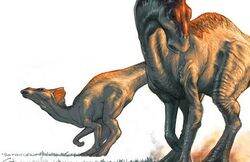
Ligocristus are highly vocal animals (typical for lambeosaurines). The valleys echo constantly with their trumpet-like vocalizations as they call to one another to maintain herd cohesiveness while moving through the dense and obscuring jungle, and to reassure one another of safety when feeding in the open. Their vocabulary is surprisingly large, with a range of calls for different purposes. Soft rumbles made while eating signal the availability of different foods to each other and complex grunts are used to communicate social messages of dominance and mood between individuals.
Breeding[]

Sporting prominent bony crests with long trailing flaps of skins, Ligocristus are able to communicate mood and breeding status visually. In a mechanism similar to that of a chameleon, chromatophores in a Ligocristus crest skin flap can flush to create different hues on the skin as a result of hormonal signals. In the breeding season, males will signal dominance and sexual maturity with deep vermilion crest displays and bellows. Males excavate performance scratches in the earth and compete for female attention with posturing and loud calls. Territorial sparring matches over the best display positions are common. In the breeding season, exhausted competitors make easy pickings for wise predators.
Skull Adaptations[]
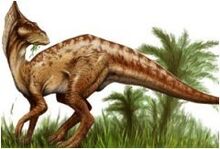
Ligocristus skulls include several specialized features supporting their lifestyle. Highly vocal, they have enlarged resonating chambers in their skulls and crests, through which they are able to trumpet loud calls to one another.
Their broad snouts widen into hard, flat beaks, ideal for plucking and grinding a wide range of vegetation. Powerful muscles drive their strong jaws, which lack front teeth but are lined with low, hard molars at the back. Vegetable matter mashed between horny plates of the beak is passed back to be thoroughly pulverized and pulped before swallowing. A distinctive side-to-side chewing motion and the ability to store food in the cheeks lends these dinosaurs a distinctly cattle-like countenance as they quietly feed, perpetually chewing on their end.
Eyes on the Horizon[]
As the main course of many of the island’s predators, Ligocristus are forced to maintain a constant lookout for danger. Eyes are positioned high on the head and angled outward to take in an almost 360-degree view. The pupils are horizontally slotted to concentrate vision along the horizon line. At their most vulnerable during low feeding, when their heads are down, their eyes are able to swivel, maintaining a horizontal bias regardless of the snout’s angle.
Island Breeding Sanctuaries[]
Seeking to avoid predators and egg thieves, some Ligocristus mothers choose to nest on small islets and sandbars in the swamps that are exposed during the driest months. Away from predatory eyes, the nests are less likely to be raided. Few of Skull Island’s land-based predators are inclined to swim, and the river’s own resident carnivores are mostly water-bound.
Left to develop on their own, the small clutches of eggs will hatch in synchronized batches to maximize the chances of survival for the young. Calls of the hatchlings draw their parents back to the islands, where they will stay for several days until the young are strong enough to risk leaving the safety of the sanctuaries.
For adults, the short swim across a river or through marshlands is no great hardship. For new hatchlings, however, this trip can be perilous: several species of water predators (such as Hydruscimex, Inoxes, Udusaurs, and Skull Island Snappers) make it their business to be waiting nearby when the adult Ligocristus return to guide their young back to land again after hatching.
Trivia[]
- Given the fact that this species of hadrosaur has great swimming abilities, Ligocristus is one of the few species of Skull Island's megafauna that would have survived the 1948 earthquake without the need for human intervention. This species most likely would have swam to nearby islands.


